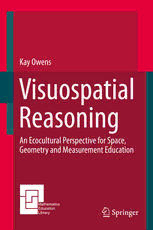
Visuospatial Reasoning: An Ecocultural Perspective for Space, Geometry and Measurement Education PDF
Preview Visuospatial Reasoning: An Ecocultural Perspective for Space, Geometry and Measurement Education
Kay Owens Visuospatial Reasoning An Ecocultural Perspective for Space, Geometry and Measurement Education Mathematics Education Library More information about this series at h ttp://www.springer.com/series/6276 Kay Owens Visuospatial Reasoning An Ecocultural Perspective for Space, Geometry and Measurement Education Kay Owens School of Teacher Education Charles Sturt University Dubbo , NSW , Australia ISSN 0924-4921 ISSN 2214-983X (electronic) ISBN 978-3-319-02462-2 ISBN 978-3-319-02463-9 (eBook) DOI 10.1007/978-3-319-02463-9 Springer Cham Heidelberg New York Dordrecht London Library of Congress Control Number: 2014945742 © Springer International Publishing Switzerland 2015 T his work is subject to copyright. All rights are reserved by the Publisher, whether the whole or part of the material is concerned, specifi cally the rights of translation, reprinting, reuse of illustrations, recitation, broadcasting, reproduction on microfi lms or in any other physical way, and transmission or information storage and retrieval, electronic adaptation, computer software, or by similar or dissimilar methodology now known or hereafter developed. Exempted from this legal reservation are brief excerpts in connection with reviews or scholarly analysis or material supplied specifi cally for the purpose of being entered and executed on a computer system, for exclusive use by the purchaser of the work. Duplication of this publication or parts thereof is permitted only under the provisions of the Copyright Law of the Publisher’s location, in its current version, and permission for use must always be obtained from Springer. Permissions for use may be obtained through RightsLink at the Copyright Clearance Center. Violations are liable to prosecution under the respective Copyright Law. T he use of general descriptive names, registered names, trademarks, service marks, etc. in this publication does not imply, even in the absence of a specifi c statement, that such names are exempt from the relevant protective laws and regulations and therefore free for general use. While the advice and information in this book are believed to be true and accurate at the date of publication, neither the authors nor the editors nor the publisher can accept any legal responsibility for any errors or omissions that may be made. The publisher makes no warranty, express or implied, with respect to the material contained herein. Printed on acid-free paper Springer is part of Springer Science+Business Media (www.springer.com) This book is dedicated to the people of Papua New Guinea and the Glen Lean Ethnomathematics Centre at the University of Goroka, PNG. Acknowledgements I wish to thank the many people of Papua New Guinea and Aboriginal Australia who have welcomed me into their homes and their knowledges, directly and indi- rectly. I hope this book illustrates a glimpse of the wealth of your cultures and my respect for you. There are too many to thank individually but I would particularly like to acknowledge Wilfred Kaleva and Rex Matang for their years of sharing and caring. I also want to thank the Dubbo Aboriginal community especially the Elders, my colleagues at Charles Sturt University (too many to name), and Diane McNaboe for teaching me Wiradjuri. I want to thank my husband Chris for his endless patience, support, and editorial work over the many years that the ideas of this book have been recorded. For their comments on drafts, I appreciate and was inspired by Peter Galbraith, Philip Clarkson, and the writing group in my School of Teacher Education at CSU, and for their contributions both in conversations, research and writing to the contributing authors─Kate Highfi eld, Ravi Jawahir, and Marcos Cherinda. vii Contents 1 Introduction: Visuospatial Reasoning in Context ................................ 1 The Challenge ........................................................................................... 1 Historical Overview of Relevant Research on Spatial Abilities and Visual Imagery ................................................................................... 2 Visuospatial Reasoning and School Test Performance ............................. 3 Visuospatial Reasoning in Mathematics Education Research .................. 5 Defi ning Visuospatial Reasoning .............................................................. 6 Extending the Meaning of Visuospatial Reasoning .................................. 9 Visuospatial Reasoning and Geometry ..................................................... 10 Bridging from the Psychological to the Ecocultural Perspective ............. 11 An Ecocultural Perspective on Learning .................................................. 12 Ecocultural Identity and Mathematical Identity ....................................... 14 Moving Forward ....................................................................................... 16 2 Visuospatial Reasoning in Twentieth Century Psychology-Based Studies ...................................................................... 19 The Challenge ........................................................................................... 19 Visuospatial Reasoning and Studies on Spatial Abilities ......................... 20 Visuospatial Reasoning from an Information Processing Perspective ...... 22 Studies of Learners with Disabilities ........................................................ 24 Age and Visuospatial Reasoning .............................................................. 26 Visuospatial Reasoning on Different Tasks .............................................. 29 Personal Approaches to Visuospatial Reasoning ...................................... 31 Training ..................................................................................................... 33 Key Study on Children’s Visuospatial Reasoning .................................... 35 Visuospatial Reasoning—Getting Inside Children’s Heads ..................... 40 Holistic, Concrete, Pictorial Imagery .................................................... 43 Dynamic Visuospatial Reasoning ......................................................... 45 Visuospatial Action Reasoning ............................................................. 47 Pattern Visuospatial Reasoning ............................................................. 51 Procedural Visuospatial Reasoning ....................................................... 57 ix
